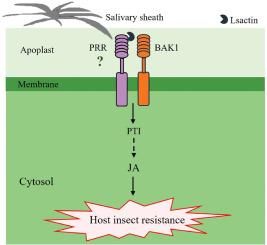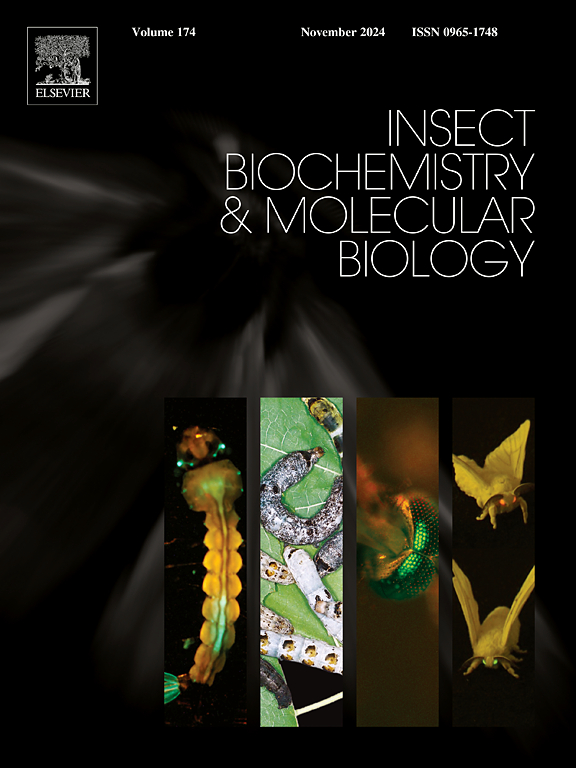唾液鞘蛋白Lsactin触发植物防御反应。
IF 3.7
2区 农林科学
Q2 BIOCHEMISTRY & MOLECULAR BIOLOGY
引用次数: 0
摘要
唾液中的草食相关分子模式(HAMPs)使植物能够识别草食动物并激活模式触发免疫(PTI)。刺吸食草动物分泌凝胶状唾液,形成唾液鞘,有助于进食。然而,这些鞘内蛋白质在调节植物防御中的作用仍然知之甚少。在这项研究中,我们从小褐飞虱(ladelphax striatellus)的唾液鞘中鉴定了一个耐热的HAMP,即肌动蛋白相关蛋白1 (Lsactin)。Lsactin是一种广泛保守的节肢动物蛋白,可作为benthamiana中bak1依赖性PTI反应的诱导剂,从而增强其对烟粉虱和frugiperda的抗性。此外,该HAMP还能诱导茄子、棉花、辣椒、玉米等植物的细胞死亡。植物能够特异性识别lscactin 41-氨基酸肽(LP41),这是一个最小的免疫原性表位。此外,LP41刺激水稻产生茉莉酸和过氧化氢,增强水稻对SBPH的抗性。然而,在SBPH中沉默Lsactin会导致唾液鞘形成中断,从而降低昆虫的摄食效率。本研究表明,来自SBPH唾液鞘的Lsactin作为一个关键的HAMP,触发植物对各种昆虫的抗性。本文章由计算机程序翻译,如有差异,请以英文原文为准。

Laodelphax striatellus salivary sheath protein Lsactin triggers defense response in plants
Herbivore-associated molecular patterns (HAMPs) in saliva enable plants to detect herbivores and activate pattern-triggered immunity (PTI). Piercing-sucking herbivores secrete gel-like saliva that forms salivary sheaths, which aid in feeding. However, the role of proteins within these sheaths in modulating plant defenses remains poorly understood. In this study, we identified a thermostable HAMP, actin-related protein 1 (Lsactin), from the salivary sheath of the small brown planthopper (SBPH) Laodelphax striatellus. Lsactin is a widely conserved arthropod protein that serves as an inducer of the BAK1-dependent PTI response in Nicotiana benthamiana, thereby enhancing its resistance to both Bemisia tabaci and Spodoptera frugiperda. Moreover, this HAMP can also induce cell death in plants such as eggplant, cotton, pepper, and corn. Plants were able to specifically recognize the Lsactin 41-amino-acid peptide (LP41), which functions as a minimal immunogenic epitope. Furthermore, LP41 stimulates the production of jasmonic acid and hydrogen peroxide in rice, enhancing rice's resistance to the SBPH. However, silencing Lsactin in SBPH led to the disruption of salivary sheath formation, which reduced insect feeding efficiency. This study demonstrates that Lsactin from the SBPH salivary sheath serves as a crucial HAMP, triggering plants resistance to various insect species.
求助全文
通过发布文献求助,成功后即可免费获取论文全文。
去求助
来源期刊
CiteScore
7.40
自引率
5.30%
发文量
105
审稿时长
40 days
期刊介绍:
This international journal publishes original contributions and mini-reviews in the fields of insect biochemistry and insect molecular biology. Main areas of interest are neurochemistry, hormone and pheromone biochemistry, enzymes and metabolism, hormone action and gene regulation, gene characterization and structure, pharmacology, immunology and cell and tissue culture. Papers on the biochemistry and molecular biology of other groups of arthropods are published if of general interest to the readership. Technique papers will be considered for publication if they significantly advance the field of insect biochemistry and molecular biology in the opinion of the Editors and Editorial Board.

 求助内容:
求助内容: 应助结果提醒方式:
应助结果提醒方式:


